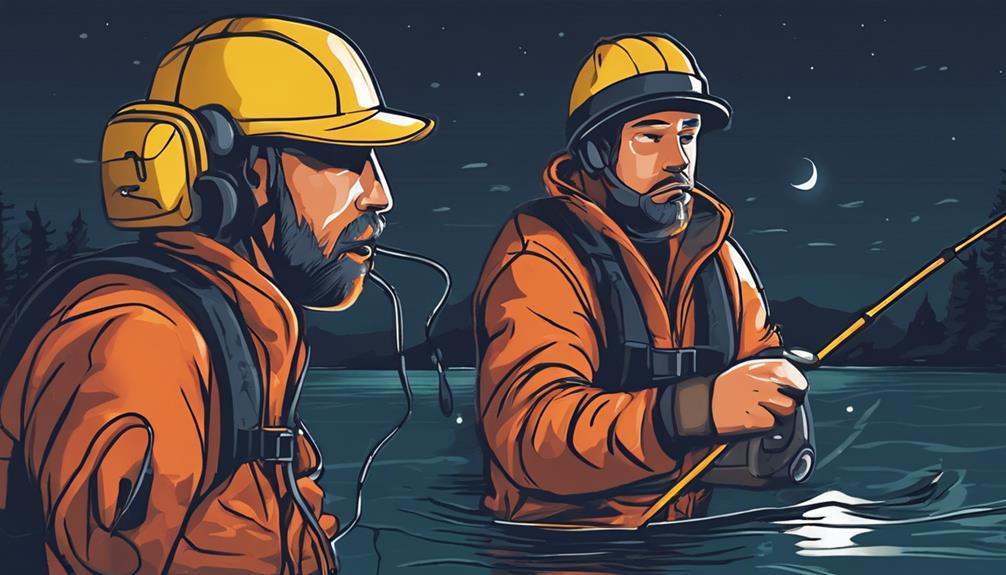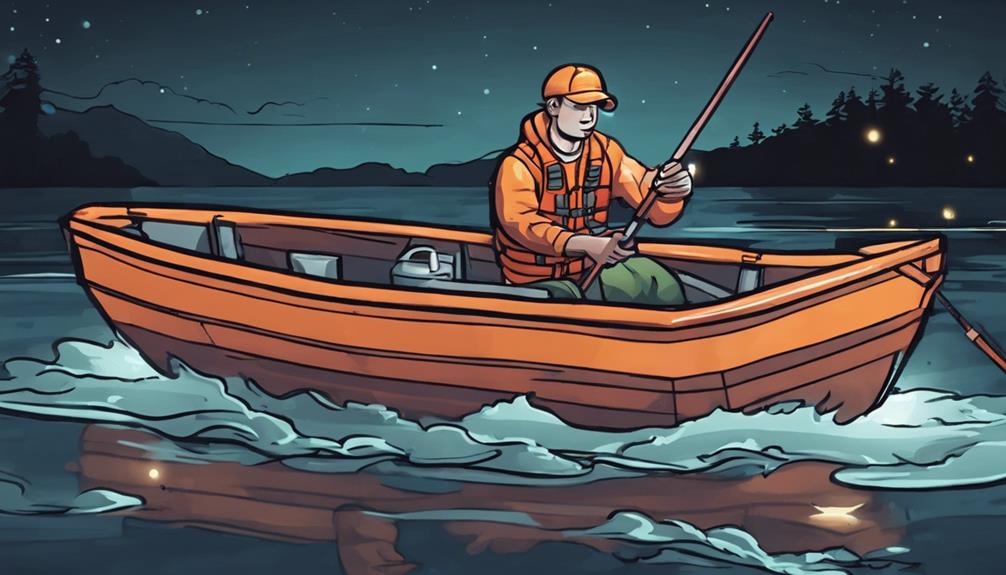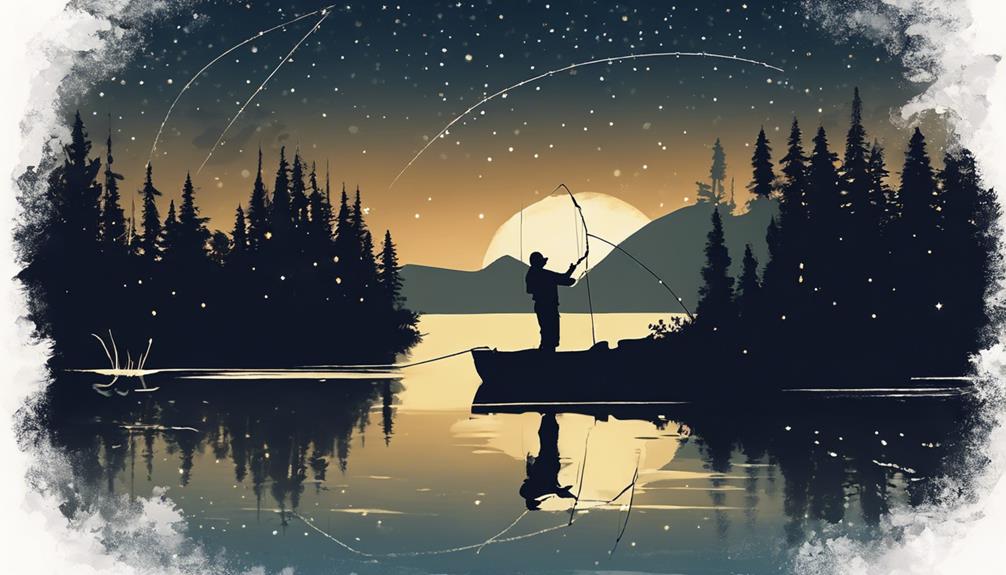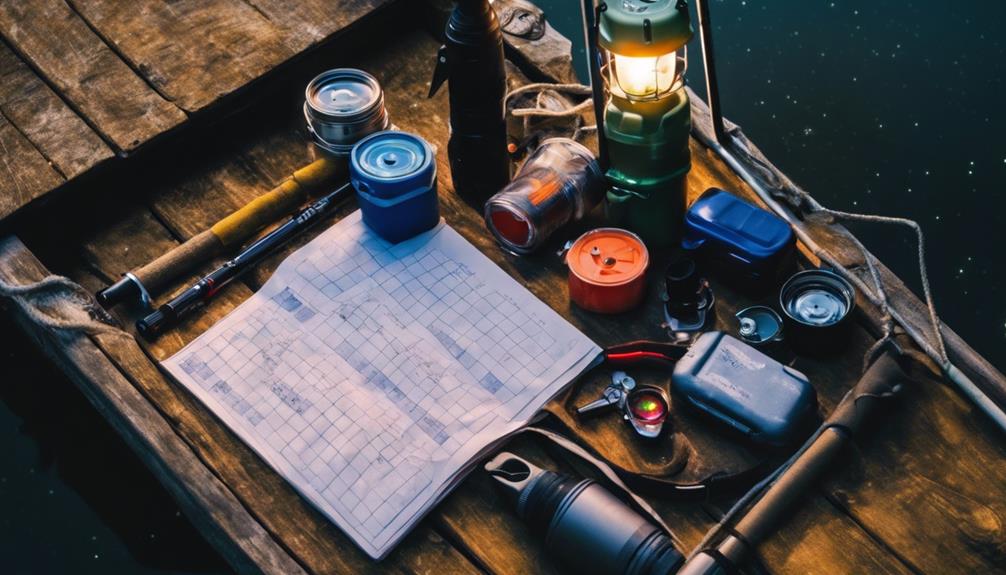Having the right safety gear for night fishing is essential for your protection in low-light situations. Enhance visibility with reflective vests and a reliable flashlight. Be prepared with a first aid kit and navigation tools like GPS. Equip yourself with a high-quality headlamp and portable LED lights for hands-free lighting. Wear waterproof clothing and sturdy boots for comfort and safety. Safety signaling devices like whistles and alarms are crucial in emergencies. Personal Floatation Devices should be snug for freedom of movement. Communication tools like VHF radios and GPS trackers add layers of security. Weather monitoring tools are vital for informed decisions.
Importance of Night Fishing Safety Gear
When night fishing, always ensure you have the necessary safety gear to protect yourself in low-light conditions. Visibility enhancement is crucial for your safety, so consider wearing a reflective vest or using reflective tape on your equipment. This will help other boaters see you in the dark. Additionally, having a flashlight or headlamp with fresh batteries is essential for seeing where you're stepping and for signaling in case of emergencies.
Emergency preparedness is another key aspect to consider. Make sure to pack a first aid kit with basic supplies like bandages, antiseptic wipes, and pain relievers. It's also wise to have a waterproof bag with emergency essentials such as matches, a whistle, and a multi-tool. These items can be invaluable in unexpected situations.
Navigation assistance is vital when navigating dark waters. Carry a GPS device or a compass to help you find your way, especially if you're in an unfamiliar area. Knowing your location can prevent you from getting lost and aid in your safe return. Additionally, consider bringing a map of the area as a backup.
Wildlife deterrence is important for your safety. Avoid attracting unwanted attention from animals by properly storing your food and trash. Use bear-proof containers if necessary and be cautious around water where alligators or other dangerous wildlife may be present. Stay alert and make noise to ward off any curious creatures. By being prepared with the right safety gear, you can enjoy your night fishing adventure with peace of mind.
Essential Lighting Equipment
To ensure optimal visibility and safety during your night fishing excursions, equipping yourself with essential lighting equipment is paramount. Proper illumination plays a crucial role in enhancing visibility during the darker hours, allowing you to navigate your boat, locate gear, and ensure you can safely fish.
One of the key pieces of lighting equipment for night fishing is a high-quality headlamp. A headlamp frees up your hands, making it easier to handle your fishing gear while providing direct light where you look. Look for headlamps with adjustable brightness settings and a red light option to preserve your night vision.
Additionally, having portable LED lights or lanterns on board can greatly enhance visibility on your boat. These lights can be used to illuminate the deck, set up near your fishing spot, or even attract baitfish. It's important to choose lights that are waterproof and have a long battery life to last through your fishing trip.
Another essential lighting tool is reflective tape. Applying reflective tape to your fishing gear, boat, or even clothing can help others spot you in the dark. This simple addition can significantly increase your visibility and safety while out on the water at night.
Protective Clothing and Footwear
Equipping yourself with proper protective clothing and footwear is essential for ensuring your safety and comfort during night fishing expeditions. When it comes to protective clothing, waterproof jackets are a must-have. These jackets not only keep you dry in case of unexpected rain but also provide an extra layer of insulation to shield you from the cold night air. Look for jackets specifically designed for outdoor activities, as they typically offer features like adjustable cuffs and hoods to keep water out effectively.
In addition to waterproof jackets, investing in durable boots is crucial for navigating potentially slippery and rocky terrains often found near fishing spots. Opt for boots with sturdy soles that provide good traction to prevent slipping on wet surfaces. High-quality fishing boots are usually made from materials that are both waterproof and breathable, keeping your feet dry and comfortable throughout your fishing trip.
Safety Whistles and Alarms
Safety whistles and alarms play a crucial role in alerting others to your location and signaling for help in emergency situations while night fishing. When you're out on the water during nighttime, visibility is limited, and unexpected emergencies can arise. This is where safety whistles and alarms become essential tools for ensuring your safety and the safety of those around you.
A safety whistle is a simple yet effective device that can be heard over long distances, even in challenging conditions like strong winds or heavy rain common during night fishing. In case of an emergency, three short blasts on a whistle are internationally recognized as a distress signal. By carrying a whistle with you while night fishing, you can quickly grab attention and alert others to your location if you need assistance.
Similarly, safety alarms are designed to emit loud sounds that can cut through the darkness and attract attention. These alarms are handy for signaling danger or calling for help during night fishing emergencies. Whether you encounter a sudden storm, your boat malfunctions, or you need urgent assistance, having a safety alarm can be a lifesaver by alerting nearby boats or people to your situation.
Personal Floatation Devices (PFDs)
When out on the water for night fishing, ensuring you have proper personal floatation devices (PFDs) is essential for your safety and peace of mind. PFDs come in various styles, including inflatable and foam options, but regardless of the type, two critical aspects to consider are proper fit and comfortable design.
Firstly, the proper fit of a PFD is crucial. It should be snug but not restrictive, allowing you to move freely while staying securely fastened to your body. A PFD that's too loose may ride up when in the water, impacting its effectiveness in keeping you afloat. On the other hand, one that's too tight can be uncomfortable and restrict your movements, causing potential discomfort during your night fishing expedition.
Secondly, opt for a PFD with a comfortable design. Look for features like adjustable straps and breathable materials to ensure a pleasant wearing experience throughout your fishing trip. A comfortable PFD is more likely to be worn consistently, increasing your safety levels while on the water.
First Aid Kit Essentials
During your night fishing excursions, having a well-stocked first aid kit with essential supplies is paramount for addressing potential emergencies swiftly and effectively.
When it comes to wound care, your first aid kit should include adhesive bandages in various sizes, sterile gauze pads, adhesive tape, antiseptic wipes, and antibiotic ointment to clean and dress minor cuts and scrapes. In case of more severe injuries, having items like a sterile eyewash solution, instant cold packs for swelling, and a roll of elastic bandage can assist in providing initial care before seeking medical assistance.
For emergency response, it's crucial to have basic supplies such as disposable gloves to prevent contamination, scissors to cut bandages or clothing if needed, tweezers for removing splinters or debris, and a CPR face shield in case resuscitation is required. Additionally, including a small booklet with first aid instructions can guide you on how to address different medical situations promptly.
Communication Devices for Emergencies

Equipping yourself with reliable communication devices is essential for swiftly addressing emergencies during your night fishing expeditions. When venturing out into the waters after dark, you must prioritize safety and preparedness. Here are three crucial communication devices to consider bringing along:
- Emergency Communication Radio: A waterproof VHF radio is a vital tool for emergency communication on the water. In case of unforeseen circumstances such as a medical emergency or a boat malfunction, a VHF radio allows you to contact nearby vessels or emergency services for assistance. Ensure you're familiar with operating the radio and have it easily accessible in case of an emergency.
- Personal Locator Beacon (PLB): A PLB is a compact and powerful device that, when activated, sends a distress signal with your GPS location to emergency responders. This is especially useful in situations where verbal communication may not be possible. Make sure your PLB is registered and up to date to ensure a swift response in case of an emergency.
- GPS Tracking Device: A GPS tracking device can provide an added layer of safety by allowing your whereabouts to be monitored in real-time. In case you need assistance, rescuers can easily locate you using the GPS coordinates provided by the tracking device. Having a GPS tracking device can significantly reduce response time during emergencies, potentially saving lives.
Weather Monitoring Tools
To enhance your safety and preparedness during night fishing expeditions, utilizing weather monitoring tools is crucial for staying informed about changing conditions. Lightning detectors are essential tools that can warn you of approaching storms, allowing you to take necessary precautions to avoid dangerous situations. These detectors work by sensing the electrostatic field changes that occur when lightning is about to strike, providing you with valuable time to seek shelter.
In addition to lightning detectors, GPS trackers are invaluable for monitoring weather patterns and keeping track of your location. GPS trackers can provide real-time updates on weather conditions, allowing you to make informed decisions about whether to continue fishing or head back to shore. By knowing the exact coordinates of your position, you can also quickly communicate your location to emergency services if the need arises.
When choosing weather monitoring tools for night fishing, opt for devices that are portable, durable, and easy to use in low-light conditions. Investing in quality tools can make a significant difference in your safety while fishing at night. Remember, being proactive and prepared is key to enjoying a successful and safe night fishing experience.
Frequently Asked Questions
How Can I Prevent Insect Bites While Night Fishing?
To prevent insect bites while night fishing, use insect repellent containing DEET on exposed skin and clothing.
Wear long sleeves, pants, and socks to minimize skin exposure. Consider using insect-repellent clothing and gear for added protection.
Avoid scented lotions or perfumes that may attract insects. Keep your fishing area well-lit to deter insects.
These precautions can help you enjoy your night fishing experience without being bothered by pesky bites.
Are There Specific Safety Precautions for Fishing Near Docks?
When fishing near docks at night, remember dock safety and nighttime visibility.
Always watch your step to avoid tripping or falling into the water. Use a flashlight or headlamp to illuminate your surroundings.
Secure your boat properly to prevent accidents. Be cautious of slippery surfaces and sharp edges on the dock.
Keep safety gear like life jackets easily accessible. Prioritize safety to enjoy your fishing experience near docks after dark.
What Should I Do if My Safety Whistle Gets Wet?
If your safety whistle gets wet, it's essential to dry it thoroughly before use to ensure it functions properly. Emergency signaling relies on your whistle emitting loud sound signals.
To maintain your safety gear, regularly check for any moisture and consider waterproofing options.
Can Reflective Tape Be Added to Existing Clothing for Visibility?
To enhance visibility, you can DIY reflective gear by adding reflective tape to your existing clothing. This simple trick significantly improves your safety during night fishing trips.
Reflective tape reflects light, increasing your visibility to others. By incorporating this into your attire, you ensure that you're easily spotted in low-light conditions.
Stay safe while enjoying your nighttime fishing adventures with this effective visibility enhancement technique.
How Often Should I Replace the Batteries in My Safety Alarm?
You should replace the batteries in your safety alarm every six months to ensure reliable performance. Remember to properly dispose of old batteries according to local regulations for safe recycling.
Regular maintenance is key to keeping your alarm functioning correctly. If you experience any issues with the alarm, troubleshoot by checking the battery connections and testing the alarm in different conditions.
Stay proactive to ensure your safety gear is always ready for use.
Conclusion
In conclusion, having the right safety gear for night fishing is essential for your well-being and peace of mind.
From proper lighting equipment to protective clothing and communication devices, being prepared can make all the difference in case of an emergency.
Don't overlook the importance of staying safe while enjoying your night fishing adventures.
Stay prepared and stay safe out on the water.



